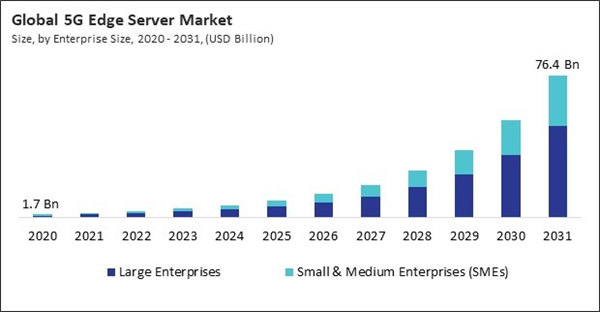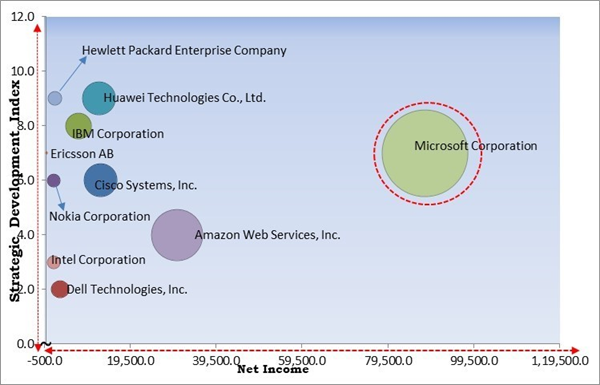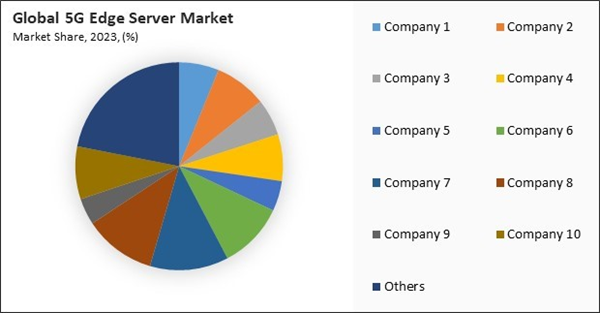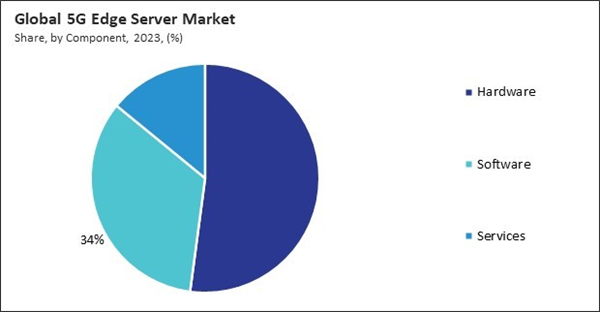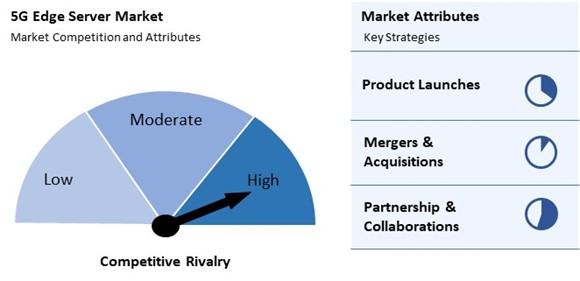The Global 5G Edge Server Market size is expected to reach $76.4 billion by 2031, rising at a market growth of 41.7% CAGR during the forecast period.
As the number of autonomous vehicles and connected car technologies continues to rise, there is a growing demand for real-time data processing and minimal latency. 5G edge servers enable vehicle-to-everything (V2X) communication, allowing autonomous vehicles to make split-second decisions, enhancing safety, and improving the overall driving experience. Thus, the automotive & transportation segment garnered 1/5th revenue share in the market in 2023. Investments in intelligent transportation systems and the increasing adoption of 5G for advanced driver-assistance systems (ADAS) have also contributed to the revenue growth in this segment.
The major strategies followed by the market participants are Partnerships as the key developmental strategy to keep pace with the changing demands of end users. For instance, In May, 2024, Amazon Web Services, Inc. partnered with Orange, an African technology company, to launch Wavelength Zones in Morocco and Senegal to provide low-latency cloud services at the Edge of 5G networks. Additionally, In September, 2024, Nokia Corporation announced a partnership with Rockwell Automation, an automation solutions provider. The aim of the partnership is to enhance industrial connectivity, improve operational efficiency, and increase network customization and security.
Beyond smart cities, 5G edge servers are vital in IoT-driven sectors like healthcare, agriculture, and manufacturing. In healthcare, wearable devices and remote patient monitoring systems generate data that needs to be analyzed instantly for timely intervention. The data collected by Internet of Things (IoT) devices in agriculture is analyzed by edge servers, which provide assistance to farmers in making educated decisions on irrigation and fertilization. These devices are employed to monitor soil health, weather conditions, and crop growth. By decentralizing data processing and bringing it closer to where it is generated, 5G edge servers facilitate smoother and more efficient IoT operations across various industries. Thus, the expansion of IoT is supporting the expansion of the market.
The leading players in the market are competing with diverse innovative offerings to remain competitive in the market. The illustration above shows the percentage of revenue shared by some of the leading companies in the market. The leading players of the market are adopting various strategies in order to cater demand coming from the different industries. The key developmental strategies in the market are Partnerships, Collaborations & Agreements.
The Market is highly competitive, fueled by the rapid expansion of 5G networks and the growing demand for low-latency, real-time processing solutions. Providers compete to offer edge servers that enhance network efficiency and support applications like IoT, autonomous vehicles, and AR/VR. The race to develop scalable, energy-efficient servers capable of handling high data loads intensifies competition, as companies aim to meet the increasing requirements of industries adopting 5G technology. Continuous innovation is crucial for maintaining a competitive edge in this evolving market.
As the number of autonomous vehicles and connected car technologies continues to rise, there is a growing demand for real-time data processing and minimal latency. 5G edge servers enable vehicle-to-everything (V2X) communication, allowing autonomous vehicles to make split-second decisions, enhancing safety, and improving the overall driving experience. Thus, the automotive & transportation segment garnered 1/5th revenue share in the market in 2023. Investments in intelligent transportation systems and the increasing adoption of 5G for advanced driver-assistance systems (ADAS) have also contributed to the revenue growth in this segment.
The major strategies followed by the market participants are Partnerships as the key developmental strategy to keep pace with the changing demands of end users. For instance, In May, 2024, Amazon Web Services, Inc. partnered with Orange, an African technology company, to launch Wavelength Zones in Morocco and Senegal to provide low-latency cloud services at the Edge of 5G networks. Additionally, In September, 2024, Nokia Corporation announced a partnership with Rockwell Automation, an automation solutions provider. The aim of the partnership is to enhance industrial connectivity, improve operational efficiency, and increase network customization and security.
KBV Cardinal Matrix - Market Competition Analysis
Based on the Analysis presented in the KBV Cardinal matrix; Microsoft Corporation are the forerunners in the 5G Edge Server Market. In March, 2023, Microsoft Corporation announced a partnership with HFCL, a telecom gear maker, to develop private 5G solutions aimed at enhancing digital transformation for enterprises in various sectors, including manufacturing and retail. Companies such as Amazon Web Services, Inc., Huawei Technologies Co., Ltd., Cisco Systems, Inc. are some of the key innovators in the Market.Market Growth Factors
Beyond entertainment, low latency is also essential in sectors such as telemedicine, autonomous vehicles, and industrial automation, where the consequences of delay can be much more severe than in gaming or media. In telemedicine, for instance, any delay in data transmission during remote surgery or patient monitoring could directly impact patient health. Similarly, vehicles must process data in real-time in autonomous driving to make critical decisions such as braking or avoiding obstacles. A 5G edge server near the data source ensures these decisions are made quickly and accurately, ultimately saving lives. Hence, as the demand for low latency in these diverse applications continues to grow, the adoption of 5G edge servers is set to expand significantly.Beyond smart cities, 5G edge servers are vital in IoT-driven sectors like healthcare, agriculture, and manufacturing. In healthcare, wearable devices and remote patient monitoring systems generate data that needs to be analyzed instantly for timely intervention. The data collected by Internet of Things (IoT) devices in agriculture is analyzed by edge servers, which provide assistance to farmers in making educated decisions on irrigation and fertilization. These devices are employed to monitor soil health, weather conditions, and crop growth. By decentralizing data processing and bringing it closer to where it is generated, 5G edge servers facilitate smoother and more efficient IoT operations across various industries. Thus, the expansion of IoT is supporting the expansion of the market.
Market Restraining Factors
Telecom companies that operate in developing countries may encounter an especially difficult financial burden. Compared to their counterparts in industrialized nations, numerous of these organizations incur budgetary constraints due to their restricted access to capital markets. Urban environments often require specialized solutions to accommodate edge infrastructure, such as utilizing rooftops or building retrofits, which can increase costs compared to setting up servers in rural areas where space is more readily available. Hence, the high implementation cost may slow down the adoption of these servers, thereby hampering the market's growth.The leading players in the market are competing with diverse innovative offerings to remain competitive in the market. The illustration above shows the percentage of revenue shared by some of the leading companies in the market. The leading players of the market are adopting various strategies in order to cater demand coming from the different industries. The key developmental strategies in the market are Partnerships, Collaborations & Agreements.
Driving and Restraining Factors
Drivers- Increased Demand for Low Latency Applications
- Growth of the Internet of Things (IoT)
- Rising Support for Autonomous Vehicles
- Considerable Investment in 5G Edge Server Infrastructure
- Limited Availability of Spectrum Suitable for 5G Deployment
- Expansion of Smart Manufacturing and Industry 4.0 Initiatives
- Increasing Use of Artificial Intelligence and Machine Learning at the Edge
- Concerns Over Data Security and Privacy
- Integration Challenges with Legacy Systems
Component Outlook
Based on component, the market is classified into hardware, software, and services. The software segment procured 34% revenue share in the market in 2023. The segment is propelled by the increasing popularity of edge computing software and platform solutions that simplify the management and optimization of 5G edge servers. Software tools enable real-time analytics, manage workloads, and ensure security in edge environments, contributing to the segment's growing revenue share.Hardware Outlook
The hardware segment is divided into servers, storage devices, and networking equipment. The servers segment recorded 43% revenue share in the market in 2023. The growing adoption of 5G technology has spurred the demand for high-performance servers that can process data at the network's edge. This technology necessitates efficient data processing in close proximity to end users to provide enhanced performance and low latency.Software Outlook
The software segment is further fragmented into network management software, edge orchestration, and security solutions. The network management software segment garnered 51% revenue share in the market in 2023. In order to properly manage the complexities of 5G edge environments, there is an increasing need for efficient network management solutions. Network management software ensures optimal network performance, reliability, and scalability by overseeing the dynamic allocation of network resources and ensuring smooth connectivity, which is crucial for supporting various edge applications in real-time.Services Outlook
The services segment is classified into consulting services, deployment & integration services, and support & maintenance services. The consulting services segment acquired 52% revenue share in the market in 2023. Consulting services provide tailored advice on the deployment of 5G edge servers, helping companies optimize performance, reduce latency, and address security concerns. The demand for specialized consulting services is further amplified by the complex nature of edge computing and its capability to transform industries such as automotive, healthcare, and manufacturing, which has led to this segment's dominant revenue share.End-use Outlook
On the basis of the end-use industry, the market is divided into telecommunications, automotive & transportation, industrial automation, healthcare, retail & e-commerce, energy & utilities, and others. The industrial automation segment procured 16% revenue share in the market in 2023. The adoption of Industry 4.0 initiatives and integration of advanced automation technologies in manufacturing has increased the demand for 5G edge servers. These servers enable real-time monitoring, predictive maintenance, and quality control, helping manufacturers optimize production processes and reduce downtime.Deployment Type Outlook
By deployment type, the market is fragmented into on-premises, cloud-based, and hybrid. The on-premises segment recorded 42% revenue share in the market in 2023. On-premises edge servers are favored by organizations that require greater control over their data, such as those in industries with stringent data privacy and security requirements, like healthcare, finance, and manufacturing. By placing edge servers on-premises, businesses can reduce the risk of data breaches.Enterprise Size Outlook
Based on enterprise size, the market is bifurcated into small & medium enterprises (SMEs) and large enterprises. The large enterprises segment witnessed 66% revenue share in the market in 2023. Large enterprises, particularly in industries such as telecommunications, automotive, and industrial automation, have the resources to invest heavily in advanced 5G edge computing infrastructure. These companies require robust and scalable edge solutions to handle high data volumes and support real-time applications, making 5G edge servers a critical part of their digital transformation strategies.Application Outlook
On the basis of application, the market is segmented into content delivery, industrial IoT, autonomous vehicles, augmented reality (AR) & virtual reality (VR), and others. The content delivery segment acquired 27% revenue share in the market in 2023. In order to mitigate latency and improve the user experience, content delivery networks (CDNs) have progressively implemented edge computing in response to the increasing demand for high-quality video streaming, online gaming, and other data-intensive applications.Technology Outlook
By technology, the market is divided into multi-access edge computing (MEC), artificial intelligence (AI) & machine learning (ML), internet of Things (IoT), network function virtualization (NFV), and others. The artificial intelligence (AI) & machine learning (ML) segment witnessed 26% revenue share in the market in 2023. In order to enable real-time decision-making for applications that necessitate rapid analysis, such as autonomous vehicles, predictive maintenance, and personalized retail experiences, AI and ML technologies are currently being deployed at the edge.Market Competition and Attributes
The Market is highly competitive, fueled by the rapid expansion of 5G networks and the growing demand for low-latency, real-time processing solutions. Providers compete to offer edge servers that enhance network efficiency and support applications like IoT, autonomous vehicles, and AR/VR. The race to develop scalable, energy-efficient servers capable of handling high data loads intensifies competition, as companies aim to meet the increasing requirements of industries adopting 5G technology. Continuous innovation is crucial for maintaining a competitive edge in this evolving market.
By Regional Analysis
Region-wise, the market is analyzed across North America, Europe, Asia Pacific, and LAMEA. The North America segment garnered 38% revenue share in the market in 2023. Numerous factors, such as the early adoption of 5G technology, substantial investments by telecom operators, and a strong emphasis on technological advancements, have contributed to this dominance. The United States, in particular, has been a leader in deploying 5G infrastructure, driven by the growing demand for applications such as autonomous vehicles, smart cities, and industrial automation.Recent Strategies Deployed in the Market
- Sep-2024: Ericsson released two new routers, the ruggedized R980 for AI, vehicle networks, and mission-critical IoT, and the compact S400 for IoT applications like digital signage and building controls. Both offer advanced 5G connectivity, security, and operational efficiency, supporting industries' increasing need for reliable, high-performance IoT solutions and network management.
- Sep-2024: Hewlett-Packard Enterprise released the ProLiant DL145 Gen11 server, designed for various Edge locations such as stores and clinics. Featuring a fourth-generation AMD Epyc 8004 processor with up to 64 cores, it supports 128 VMs, offering compact size, power efficiency, and remote management capabilities for businesses.
- Aug-2024: Ericsson AB partnered with Uscellular, a mobile network company, to enhance 5G transport infrastructure in rural U.S., improving internet speed, capacity, and reliability. Using Ericsson’s Router 6000 and new Router 6671, the collaboration supports mid-band 5G deployment, enabling services like precision agriculture, remote education, and telemedicine to boost rural digitalization and local economies.
- Jul-2024: Nokia Corporation partnered with Telefonica, a spanish telecom company. The partnership aimed to to expand Spain's private 5G network market.
- Jun-2024: Cisco Systems, Inc. partnered with Lenovo, a technology company, to deliver integrated infrastructure and networking solutions aimed at accelerating digital transformation. Their collaboration combines Lenovo’s AI infrastructure with Cisco’s networking technology, offering turnkey solutions from edge to cloud, enhancing AI-powered innovation, operational efficiency, and simplified digital workplace implementation for businesses worldwide.
List of Key Companies Profiled
- Nokia Corporation
- Huawei Technologies Co., Ltd. (Huawei Investment & Holding Co., Ltd.)
- Cisco Systems, Inc.
- Dell Technologies, Inc.
- Hewlett Packard Enterprise Company
- Ericsson AB
- Amazon Web Services, Inc.
- Intel Corporation
- IBM Corporation
- Microsoft Corporation
Market Report Segmentation
By Enterprise Size- Large Enterprises
- Small & Medium Enterprises (SMEs)
- Hardware
- Servers
- Storage Devices
- Networking Equipment
- Software
- Network Management Software
- Edge Orchestration
- Security Solutions
- Services
- Deployment & Integration Services
- Consulting Services
- Support & Maintenance Services
- On-Premises
- Cloud-based
- Hybrid
- Multi-access Edge Computing (MEC)
- Artificial Intelligence (AI) & Machine Learning (ML)
- Internet of Things (IoT)
- Network Function Virtualization (NFV)
- Other Technology
- Content Delivery
- Industrial IoT
- Autonomous Vehicles
- Augmented Reality (AR) & Virtual Reality (VR)
- Other Application
- Telecommunications
- Automotive & Transportation
- Industrial Automation
- Healthcare
- Retail & E-commerce
- Energy & Utilities
- Other End-Use Industry
- North America
- US
- Canada
- Mexico
- Rest of North America
- Europe
- Germany
- UK
- France
- Russia
- Spain
- Italy
- Rest of Europe
- Asia Pacific
- China
- Japan
- India
- South Korea
- Singapore
- Malaysia
- Rest of Asia Pacific
- LAMEA
- Brazil
- Argentina
- UAE
- Saudi Arabia
- South Africa
- Nigeria
- Rest of LAMEA
Table of Contents
Chapter 1. Market Scope & Methodology
Chapter 2. Market at a Glance
Chapter 3. Market Overview
Chapter 4. Competition Analysis - Global
Chapter 5. Global 5G Edge Server Market by Enterprise Size
Chapter 6. Global 5G Edge Server Market by Component
Chapter 7. Global 5G Edge Server Market by Deployment Type
Chapter 8. Global 5G Edge Server Market by Technology
Chapter 9. Global 5G Edge Server Market by Application
Chapter 10. Global 5G Edge Server Market by End-Use Industry
Chapter 11. Global 5G Edge Server Market by Region
Chapter 12. Company Profiles
Companies Mentioned
Some of the key companies profiled in this 5G Edge Server Market include:- Nokia Corporation
- Huawei Technologies Co., Ltd. (Huawei Investment & Holding Co., Ltd.)
- Cisco Systems, Inc.
- Dell Technologies, Inc.
- Hewlett Packard Enterprise Company
- Ericsson AB
- Amazon Web Services, Inc.
- Intel Corporation
- IBM Corporation
- Microsoft Corporation
Methodology

LOADING...



